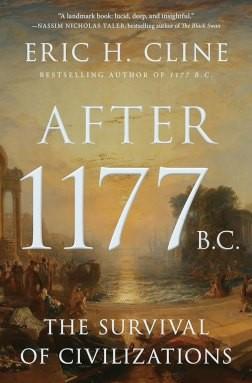Link: https://www.sciencenews.org/article/1177-bc-bronze-age-societiesreview
Please see the link above for source text.

Link: https://www.sciencenews.org/article/1177-bc-bronze-age-societiesreview
Please see the link above for source text.
June 20, 2024

After 1177 B.C.
Eric H. Cline Princeton Univ., $32
A toxic brew of calamities that included drought, earthquakes, famine, disease and invasion undermined civilizations across the Eastern Mediterranean and Near East about 3,200 years ago. But that Late Bronze Age collapse was not a one-size-fits-all event. Archaeologist Eric H. Cline sees it as a complicated tragedy and transition, with only some societies vanishing. Others took hard hits but rebounded after a few centuries or muddled through a progressive decline in power. Certain societies adapted
to a new world, or even transformed and prospered amid chaos (SN: 7/3/19).
The best of Science News - direct to your inbox
Headlines and summaries of the latest Science News articles, delivered to your email inbox every Thursday.
In After 1177 B.C., Cline consulted ancient inscriptions written on stone, clay, papyrus and more, along with other artifacts and excavated sites, to outline the many ways major Bronze Age societies responded to tumultuous times. Their divergent trajectories during the Iron Age that followed — what researchers mistakenly called a dark age until the 1980s — hold lessons for people today, Cline writes.
Anyone concerned with avoiding the end of the world as we know it might be especially interested in the societies that flourished in the wake of the Late Bronze Age collapse. Cline regards those success stories as exhibiting what Nassim Nicholas Taleb, a risk analyst, has called antifragility, an ability to get stronger in the face of disorder (SN: 4/4/13).
For instance, Central Canaanite people in coastal Middle Eastern cities, now known as Phoenicians, took over major Mediterranean maritime trade routes after the sacking of formerly dominant port cities (SN: 3/16/22).
Though trade opportunities diminished, Phoenician mariners still exchanged goods, including a popular purple dye, for silver and other metals from Sicily, Sardinia and Iberia. As their trade ties grew, Phoenicians spread an alphabetic system that formed the basis of written English and many other modern languages.
Cline discusses growing evidence for similar victories on Cyprus. People there established towns and governments in new areas as drought-related soil erosion caused silt to fill formerly busy harbors. Evidence indicates that bronze metalworkers in Cyprus pioneered technical innovations that led to a region-wide iron industry.
Among the characteristics of resilient societies: multiple contingency plans for extreme weather events and other emergencies, solid defenses against
enemy attacks, dependable water resources and a happy working class. But for others, the Late Bronze Age collapse exposed weaknesses ranging from manageable to fatal.
Assyrians and Babylonians in ancient Mesopotamia weathered the collapse with their social systems intact, Cline concludes. But royal records refer to population declines linked to drought, famine and plague, and it took centuries for these societies to regain their former prominence. That’s a form of resilient survival well short of Phoenicians’ “antifragile” growth during chaos.
Egyptian civilization “was never the same again,” Cline writes. Egypt’s power and status in international trade declined, as did the standard of living for average folks, he suggests. Mycenaean society on mainland Greece proved especially fragile, vanishing by about 3,200 years ago. But Greeks who survived slowly remade their culture and society, Cline argues. Pottery styles, burial customs and house types were developed from former Mycenaean practices. After a couple hundred years, this cultural reclamation project prompted the rise of Archaic and then Classical Greece, Cline suspects.
Amid limited records and plenty of academic debate, Cline provides a thought- provoking introduction to current thinking about the Late Bronze Age. He acknowledges that scholars won’t always agree with his views. And though multisyllabic names of ancient kings pile up quickly — an unavoidable consequence of chronicling royal successions in unstable times — a helpful list of rulers and officials appears at the end. As hard as it is to revive the past, predicting the future is even harder. Cline can’t answer whether our civilization, in the face of modern threats, will go the way of the Phoenicians or the Mycenaeans.
Buy After 1177 B.C. from Bookshop.org. Science News is a Bookshop.org affiliate and will earn a commission on purchases made from links in this article.
Questions or comments on this article? E-mail us at feedback@sciencenews.org | Reprints FAQ
A version of this article appears in the June 15, 2024 issue of Science News.

About Bruce Bower E-mail
Bruce Bower has written about the behavioral sciences for Science News since 1984. He writes about psychology, anthropology, archaeology and mental health issues.